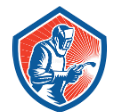This two-year course combines lab experience with related instruction. Students learn to identify and understand the composition of metals as well as to fabricate various projects. They practice oxyacetylene welding and burning, electric arc welding, gas tungsten arc welding, gas metal arc welding and plasma-arc cutting. Related studies include blueprint reading, applied mathematics and weld symbols.
Virginia Beach City Public Schools ensures equal access to all CTE courses. Accessibility accommodations will be provided as needed.
|
Welding II |
|||||
|
Unit |
The Nature of Technology  |
Welding Technology and Society  |
Design and Engineering in Welding Technology  |
Applying Design Processes in Welding Technology  |
Select and Apply Technology in Welding Technology  |
|
Focus |
Technology is a varied field of study. Students will examine the definition and applications of welding technology. |
Technology is strong influence on society. Students will understand and describe the impacts of welding technology. |
Resources are the raw materials of a technological system. Selecting and applying them toward a welding solution is essential. |
Technology is a tool to assist in solving complex welding problems. A systems approach is a framework to design solutions. |
The role of technology is diverse. Identifying the role of technology in welding is essential to an improved understanding. |
|
Transfer Goals |
|
|
|
|
|
|
Unit Learning Targets |
|
|
|
|
|
